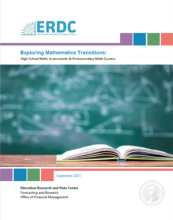This report is a descriptive assessment of the relationships between high school math course taking, performance on the standardized mathematics assessment, and postsecondary mathematics course taking. This analysis uses course-taking and assessment data for the high school Class of 2017 linked with 2018 math course-taking data for public postsecondary institutions in Washington.
This report is an extension of findings published earlier (here and here). It incorporates high school mathematics course categories developed by Office of Superintendent of Public Instruction (OSPI) and Smarter Balanced Assessment (SBA) math levels.
Since high school graduation requirements changed beginning with 9th graders entering in 2015, the findings here will serve as a benchmark to evaluate the impacts of the new requirements and the efforts to smooth the transition from high school to college-level mathematics.
This report suggests that, as expected, rigorous high school mathematics course taking and higher SBA math levels are associated with higher postsecondary college-level course taking and lower pre-college course-taking rates.


